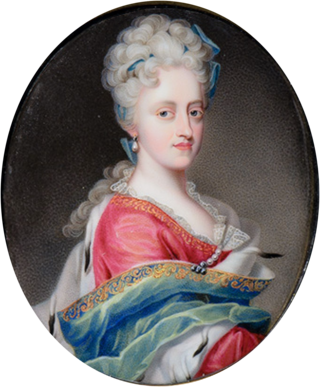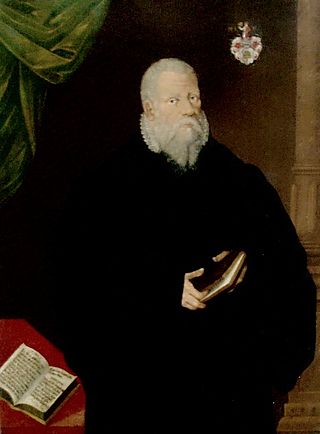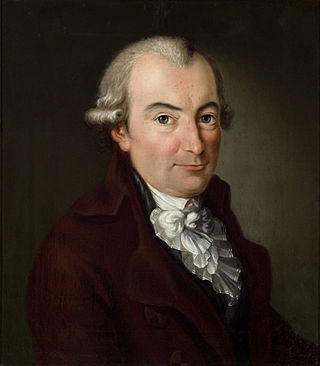Related Research Articles

Maria Magdalena of Austria was a governor of Tyrol and daughter of Leopold I, Holy Roman Emperor and his third wife Eleonor Magdalene of the Palatinate-Neuburg. She died unmarried.

Frederick Michael, Count Palatine of Zweibrücken-Birkenfeld was a member of the Wittelsbach dynasty. He was the son of Christian III of Palatinate-Zweibrücken and Caroline of Nassau-Saarbrücken and a member of the House of Palatinate-Zweibrücken-Birkenfeld, a branch of the House of Wittelsbach. He was the father of the Bavarian King Maximilian I Joseph. Furthermore, he engaged Nicolas de Pigage to reconstruct his summer palace in Oggersheim.
Daniel Christian Ludolph Lehmus was a German mathematician, who today is best remembered for the Steiner–Lehmus theorem, that was named after him.

Michael Altenburg was a German theologian and composer.
David Köler, also Koler, Colerus was a German composer.

Psalm 124 is the 124th psalm of the Book of Psalms, beginning in the English of the King James Version: "If it had not been the LORD who was on our side, now may Israel say". The Book of Psalms is part of the third section of the Hebrew Bible, and a book of the Christian Old Testament. In the slightly different numbering system used in the Greek Septuagint and the Latin Vulgate, this psalm is Psalm 123. In Latin it is known as "Nisi quia Dominus". It is one of fifteen psalms that begin with the words "A song of ascents". Using "conventional metaphors", it recalls the dangers faced by Israel from which the nation has been rescued.

Psalm 127 is the 127th psalm of the Book of Psalms, beginning in English in the King James Version: "Except the Lord build the house". In Latin, it is known by the incipit of its first 2 words, "Nisi Dominus". It is one of 15 "Songs of Ascents" and the only one among them attributed to Solomon rather than David.

Ludwig Helmbold, also spelled Ludwig Heimbold, was a poet of Lutheran hymns. He is probably best known for his hymn "Nun laßt uns Gott dem Herren", of which J. S. Bach used the fifth stanza for his cantata O heilges Geist- und Wasserbad, BWV 165; Bach also used his words in BWV 73, 79 and 186a.
Bartholomäus Ringwaldt was a German didactic poet and Lutheran pastor. He is most recognized as a hymnwriter.
There are 52 chorale cantatas by Johann Sebastian Bach surviving in at least one complete version. Around 40 of these were composed during his second year as Thomaskantor in Leipzig, which started after Trinity Sunday 4 June 1724, and form the backbone of his chorale cantata cycle. The eldest known cantata by Bach, an early version of Christ lag in Todes Banden, BWV 4, presumably written in 1707, was a chorale cantata. The last chorale cantata he wrote in his second year in Leipzig was Wie schön leuchtet der Morgenstern, BWV 1, first performed on Palm Sunday, 25 March 1725. In the ten years after that he wrote at least a dozen further chorale cantatas and other cantatas that were added to his chorale cantata cycle.

Wo Gott der Herr nicht bei uns hält, BWV 178, is a church cantata by Johann Sebastian Bach. He composed it in Leipzig for the eighth Sunday after Trinity and first performed it on 30 July 1724.

"Wo Gott der Herr nicht bei uns hält" is a Lutheran hymn by Justus Jonas, a paraphrase of Psalm 124 in eight stanzas. It was first published in 1524 in the Erfurt Enchiridion. The theme of the psalm is the need of help against raging enemies. It has been translated also as "Where the Lord God does not stand (stay) with us", "If God the Lord is not with us", "If God the Lord is not on our side", among others.
Christian Heinrich Postel was a German jurist, epic poet and opera librettist, who wrote 28 libretti for the Oper am Gänsemarkt in Hamburg: set by composers such as Johann Philipp Förtsch, Reinhard Keiser and Georg Philipp Telemann. His texts for a St John Passion were set by composers Christian Ritter, Johann Mattheson and Johann Sebastian Bach in their respective St John Passion.
Melchior Teschner was a German cantor, composer and theologian.

Johann Erich Biester was a German philosopher. With Friedrich Nicolai and Friedrich Gedike, he formed what was known as the 'Triumvirate' of late Enlightenment Berlin.
Gottfried Wilhelm Sacer was a German jurist, poet, satirist and Protestant hymn writer. He worked as an advocate at the court of Wolfenbüttel. Johann Sebastian Bach used a stanza from his hymn "Gott fähret auf gen Himmel" to conclude his Ascension Oratorio. Another hymn, Jesu, meines Glaubens Zier, appears in the 1736 Schemelli Gesangbuch in a setting attributed to Bach.

Johann Karl Christoph Nachtigal was a German Protestant theologian and philologist. His best-known publication is Peter the Goatherd; the folk tale became the model for Washington Irving's first short story Rip Van Winkle.
Johann Kolross was a poet, philologist and educator of the German Renaissance and the Protestant Reformation. He studied in Freiburg, and worked as rector of the boys' school in Basel from 1529. He published the Enchiridion, a textbook on orthography, in 1530.

"Was mein Gott will, das g'scheh allzeit" is a Lutheran hymn in German. The text from c. 1550 is attributed to Albert, Duke of Prussia. The melody, Zahn No. 7568, goes back to a tune by Claudin de Sermisy, written in 1529 for a secular French song. The hymn has belonged to core Lutheran hymnody without interruption and is part of the Protestant hymnal Evangelisches Gesangbuch as EG 364.

"Das Grab ist leer, der Held erwacht" is a Catholic hymn for Easter, first printed in 1777 in the hymnal Landshuter Gesangbuch published by Franz Seraph von Kohlbrenner. Keeping only the first of five stanzas, with additional two stanzas, it appeared in hymnals of the 19th century, and later in different versions in several regional sections of the Catholic hymnal Gotteslob. It is a frequently sung hymn in Easter services.
References
- ↑ Allgemeine Deutsche Biographie (ADB). Band 18, Duncker & Humblot, Leipzig 1883, S. 148.
- ↑ Allgemeine Deutsche Biographie (ADB). Band 18, Duncker & Humblot, Leipzig 1883, S. 147 f.
- ↑ "Johann Adam Lehmus". hymnary.org. Retrieved 2024-09-04.